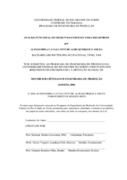Please use this identifier to cite or link to this item:
https://repositorio.ufrn.br/handle/123456789/15106| Title: | Análise funcional do design das órteses para rizartrose |
| Other Titles: | Functional analysis the orthotics design for "rizartrose" |
| Authors: | Souza, Alessandra Cavalcanti de Albuquerque e |
| Advisor: | Gouvinhas, Reidson Pereira |
| Keywords: | Rizartrose;Ortótico;Design;Função;Rizartrose;Orthotic;Design;Function |
| Issue Date: | 19-May-2006 |
| Publisher: | Universidade Federal do Rio Grande do Norte |
| Citation: | SOUZA, Alessandra Cavalcanti de Albuquerque e. Functional analysis the orthotics design for "rizartrose". 2006. 118 f. Dissertação (Mestrado em Estratégia; Qualidade; Gestão Ambiental; Gestão da Produção e Operações) - Universidade Federal do Rio Grande do Norte, Natal, 2006. |
| Portuguese Abstract: | Esta pesquisa tem como proposta investigar a utilização de dois modelos de dispositivo ortótico usados no tratamento conservador da rizartrose de pacientes/consumidores que foram encaminhados ao LAI (Laboratório de Acessibilidade Integrada) pela clínica médica. Ainda, descreve as percepções deste grupo sobre os aspectos funcionais dos dois modelos do dispositivo, avalia o valor do produto atribuído pelo paciente/consumidor e descreve a importância conferida a cada modelo. O objetivo desta pesquisa consiste em identificar entre os modelos de órtese dorsal e ventral, utilizados no tratamento conservador da rizartrose, aquele que é preferido para uso sob a ótica do próprio paciente/consumidor. Desta forma, o trabalho tem sua formação baseada na pesquisa do tipo exploratória através de investigação em fontes bibliográficas e em pesquisa de campo. Na pesquisa de campo foi adotado como procedimento metodológico o estudo de caso, por se propor a investigar o fenômeno em seu contexto real. Os dados foram coletados com a aplicação de formulário junto aos pacientes/consumidores em dois momentos-após uso de órtese dorsal e após uso de órtese ventral. O formulário busca identificar a relação de cada paciente/consumidor com os dois modelos do dispositivo. Através de uma análise descritiva geral foi verificado sobre a habilidade do paciente na execução de determinadas tarefas cotidianas em uso de órtese dorsal e ventral, sendo seguido da apresentação dos aspectos funcionais dos produtos e do valor sob a ótica do paciente/consumidor. Os resultados mostram que a preferência para uso do modelo dorsal ou ventral é determinada pelas necessidades individuais de cada pessoa. Os resultados mostram também a existência de outros pressupostos que exercem influencia na escolha do modelo pelo paciente/consumidor, como o uso de órtese na mão contralateral a dominante |
| Abstract: | The purpose of this paper is to identify the utilization of two models of orthotics used in the conservative treatment of rizartrose in patients/consumers that were referred by the medical clinic to the LAI (Laboratory of Integrated Accessibility). It describes this group s perception related to the functional aspects of the two models, evaluates the value of the product attributed by the patient/consumer and describes the importance attributed to each model. The research s objective consists in identifying which model this is preferred from the point of view by the patients that use either the dorsal or ventral models used in the conservative treatment of rizartrose . This work is then based on the exploratory research through the investigation of the bibliography available and in the research field. The research field used the case study methodology to investigate the phenomenon in the real context. The data were collected using a patient questionnaire during two times after the use of the dorsal orthotic and after the use of the ventral orthotic. The questionnaire was used to identify the relationship between the patients/consumers and the two different types of orthotics. A general descriptive analysis was used in order to verify the patient s abilities executing certain activities daily living using the dorsal and ventral orthotics, the product s functional aspects and its value from the patient s/consumer s point of view. The results show that the preference for the dorsal or ventral models is determined by the individual needs of each person. The results also show that other variables, such as the use of the orthotic on the dominant or non-dominant hand, play a role in the preferred model by the patient/consumer and need to be further investigated |
| URI: | https://repositorio.ufrn.br/jspui/handle/123456789/15106 |
| Appears in Collections: | PPGEP - Mestrado em Engenharia de Produção |
Files in This Item:
| File | Description | Size | Format | |
|---|---|---|---|---|
| AlessandraCAS.pdf | 467,09 kB | Adobe PDF |  View/Open |
Items in DSpace are protected by copyright, with all rights reserved, unless otherwise indicated.

